BY Doug Dukeson
DOUBTFUL SOUND – A JURASSIC ADVENTURE
Back in 1770 Captain Cook spotted the narrow entrance to what is now called Doubtful Sound. He was ‘doubtful’ as to whether there would be enough wind to adventure in, explore and sail out again. Naming it Doubtful Harbour, Cook sailed away in Endeavour, leaving the sound unexplored. Twenty-three years on, in 1793, Malaspina’s Spanish expedition was the first to explore and chart Doubtful Sound.
Two hundred and fifteen years after the Spanish visited, the 2008 Propeller magazine expedition followed. This was an opportunity for our crew to explore, feel the power of nature, experience the remoteness, and soak up the peace of Doubtful Sound.
In the April 2004 issue of Propeller magazine, after boat testing the Southern Sportz 770 HTE owned by charter operator Greg Dawson, we vowed we would return to the depths of the South Island for an adventure, to explore Fiordland. Just over four years later, with the help of the same Invercargill based Greg Dawson, we were to make it happen.
Eight like-minded trailerboat owners, and good friends – some invited back from the last Dawson adventure – arrived from various corners of NZ and met at Invercargill for the start of the adventure.
Borrowing a 759 SuperCab (as featured in the July/August issue of Propeller magazine) from Stabi-Craft and a Kia Sorrento from Southland Vehicle Sales as the Stabi tow vehicle, we followed Greg Dawson towing his same Southern Sportz 770 from Invercargill to the lake edge Manapouri Hotel, a trip of only about an hour and a half. Over a meal and a nice Southern ale or two that evening, we met with Phil Wornall of Fish Fiordland, who was to tow us over Wilmot Pass the next morning.
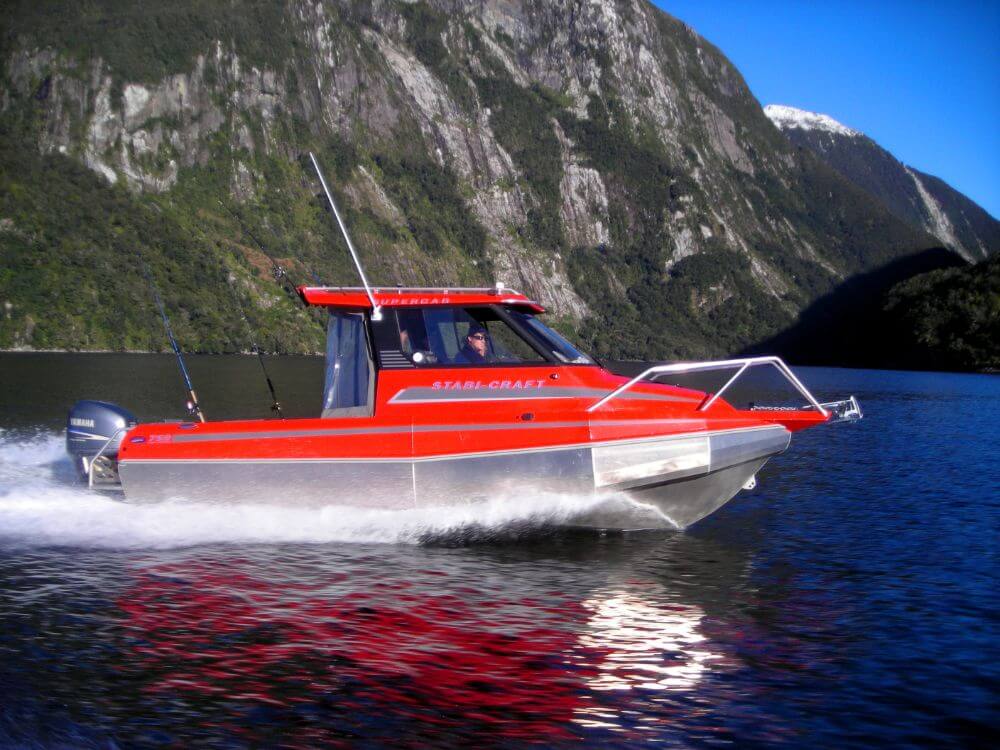
Crossing Lake Manapouri.
After a good nutritious breakfast, it was off to the ramp near Pearl Harbour at the eastern side of the lake. Phil met us and guided us across Lake Manapouri (NZ’s second deepest lake at 440 metres) – often referred to as the ‘Lake of many islands’.
At about 2 degrees above freezing we were thankful we had chosen hardtops for our adventure. The setting of the majestic, snow covered Cathedral Mountain range, dense native bush right to the lake edge, sandy beaches and coves dotted along the coast, offered something for the eye throughout the entire 45 minute journey to the West Arm, home of the Manapouri underground hydro-electric power station.
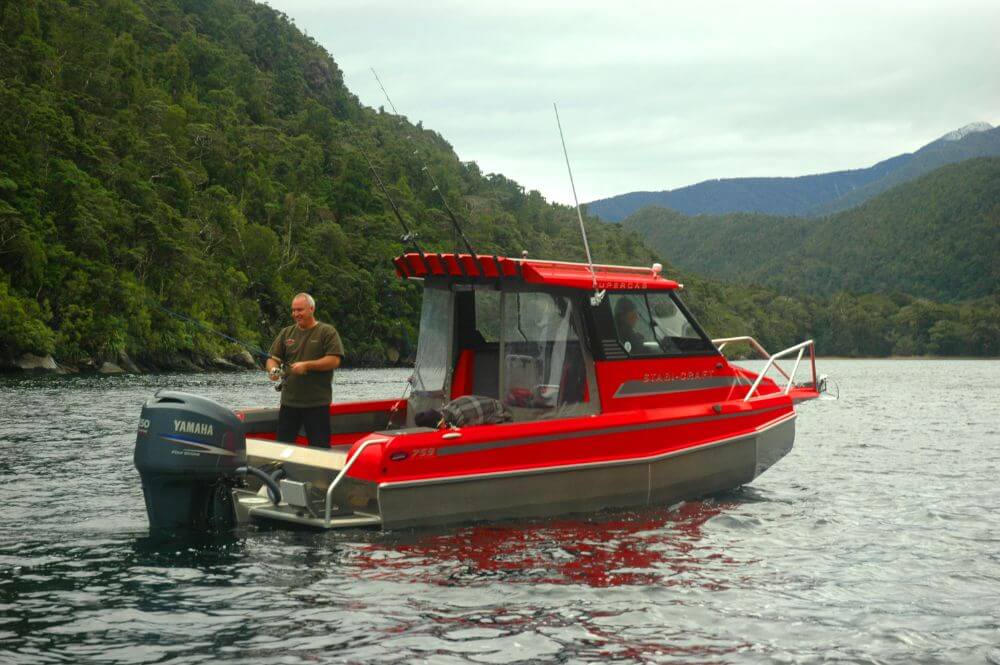
‘Over the hill’ – Wilmot Pass
After a little background information on the power station the boys were ‘amping’ to get over the mountains and into the sound.
As Phil backed the first vehicle down to the water’s edge – a 22-seater ex-commercial passenger bus – I thought to myself ‘I bet the boys on the assembly line in Japan would have never dreamed the bus would see its final years out as a tow hack!’
The second vehicle, an older Nissan Safari, arrived as the bus pulled the Stabi clear. Greg ran his Southern up on the ‘Wilmot Pass multi-fit trailer’, unfortunately the bowsprit was a little too long and a post on the front of the trailer would not allow us to push the boat far enough forward onto the trailer. Fortunately, Phil being a bit of a character and a handy man, reached into the back of his vehicle, pulled out his trusty hacksaw and soon redesigned the trailer post to allow the Southern to take its rightful position. One of our team later asked Phil if he minded attacking his trailer with a hacksaw, and he replied in his unhurried relaxed manner “No, ….not really – it’s not my trailer!”
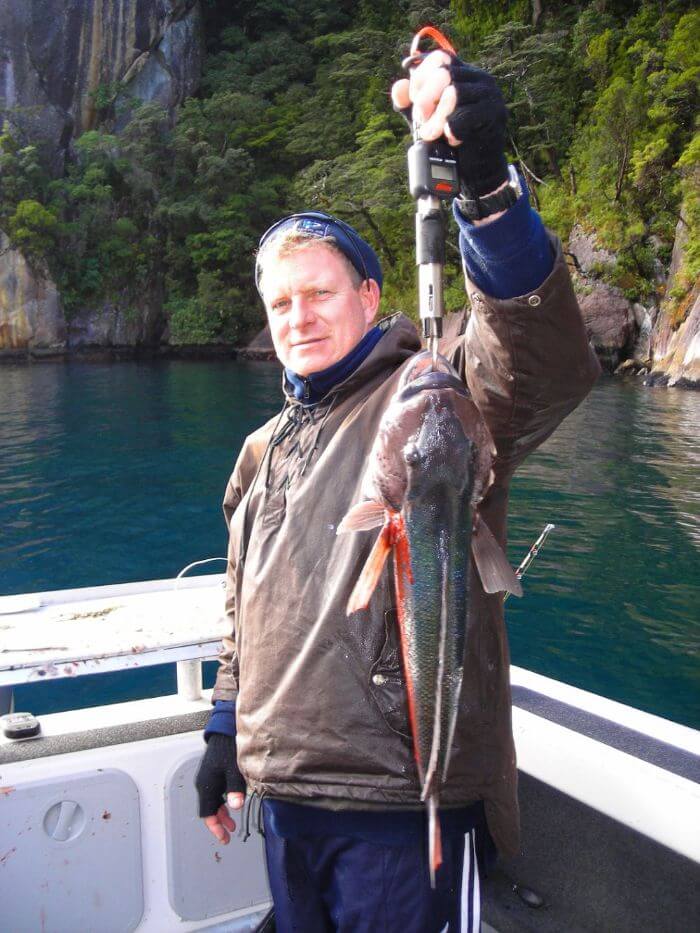
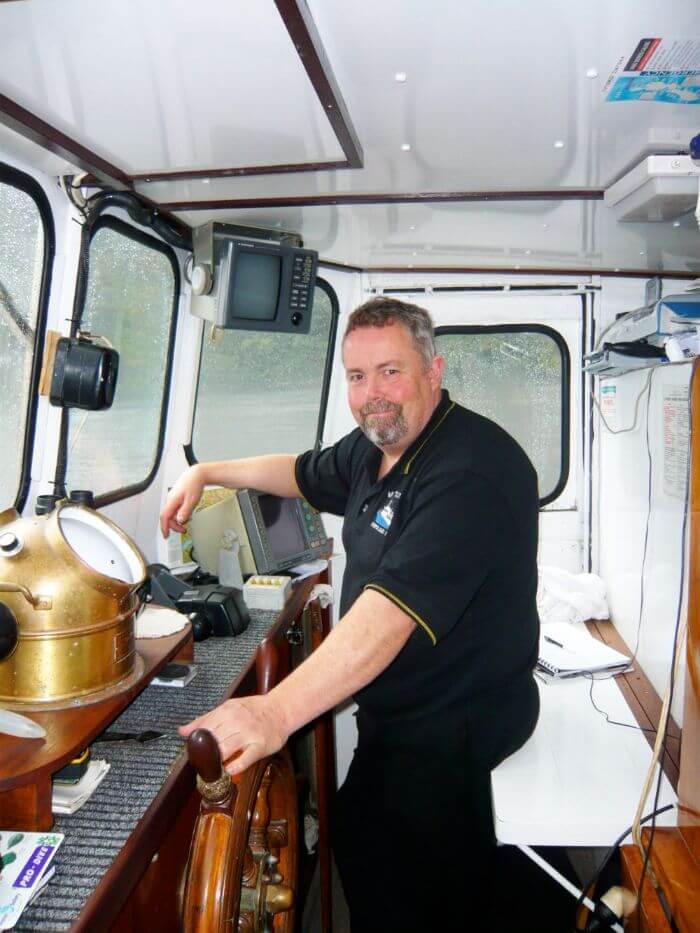
A short time later after safely strapping the boats to the trailer, we were on our way towards Wilmot Pass, the most expensive road per kilometre, ever constructed in New Zealand. It took two years, (1963-1965) to construct the 22km road, specifically to transport the equipment and personnel essential for building the Manapouri Power Station from lake Manapouri to the construction site at Deep Cove, 180 metres below the normal lake level.
We stopped for a couple of photo opportunities on the way, a team photo, looking back at the famous Wilmot track. At this first stop I mentioned to Phil that one of the tyres on the trailer seemed a little flat. Giving it a kick in his typical ‘not a problem’ manner he replied ‘Yep, it does’, he went on to explain ‘As we travel, she’ll get a bit warm and harden up.’ ‘Righto’ – I thought – ‘this man has done this trip hundreds of times, we are in safe hands!’ To be honest, even at its steepest, (a 5 to 1 gradient, one of NZ’s steepest) I felt in safe hands and the recently snow graded roads were in good condition. Phil knew his stuff and I was more than happy to be riding pillion rather than behind the wheel.

The Wilmot Pass Road is the only public road to Doubtful Sound, but it doesn’t link up with any other road. It runs from the end of the West Arm of Lake Manapouri to Deep Cove, where we were to launch our boats
Phil charges $450 for the first boat or $600 for two boats (each way) an account we did not flinch to pay, considering the potential hazards and the security of having Phil’s experience behind the wheel.
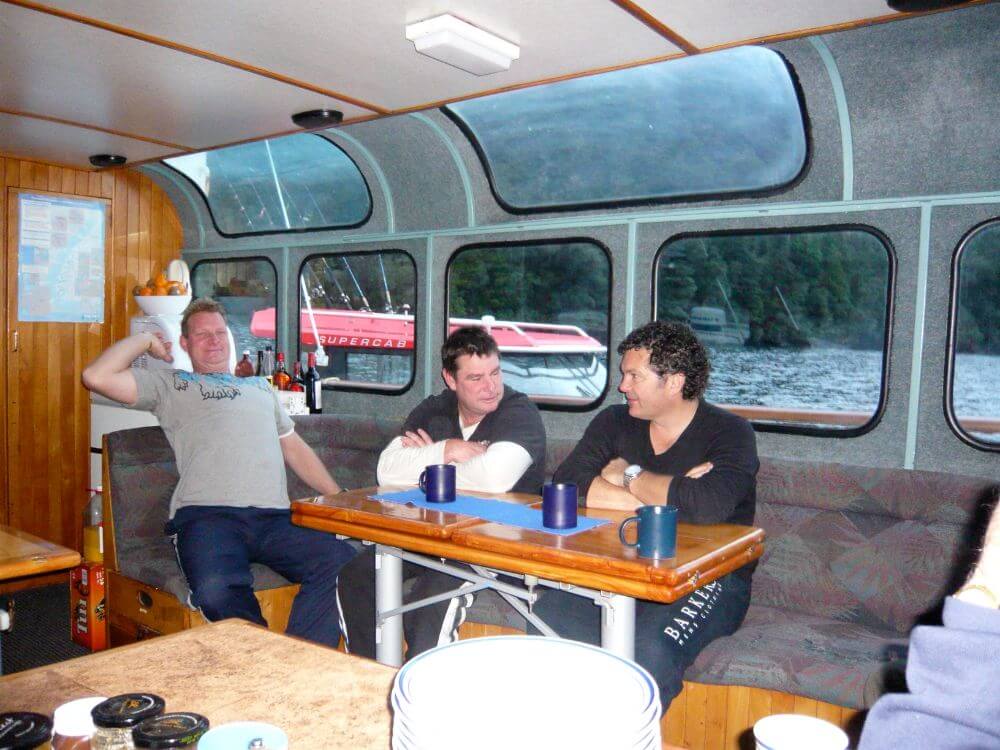
Welcome to ‘Jurassic’ Doubtful Sound
Once Phil had delivered the boats safely into Deep Cove, it was time to hook up with Richard, our very knowledgeable skipper and host for the trip, skippering the very comfortable and well-known Tutoko, a 16.6 metre vessel built by Gough Bros in 1971. Also onboard as crew and Richard’s ‘first mate’ was Alan, a seaplane pilot helping out during his off-season, another with a wealth of local knowledge and a bloody good cook – later confirmed by my bathroom scales!
Once we were tied alongside and loaded our gear onboard it was time for a quick run down on the boat by Richard – another southerner with a laid back sense of humor and relaxed approach to life, his famous ‘onboard’ line of, ‘that reminds me of a story…’ which was always the start of an entertaining tale or joke.
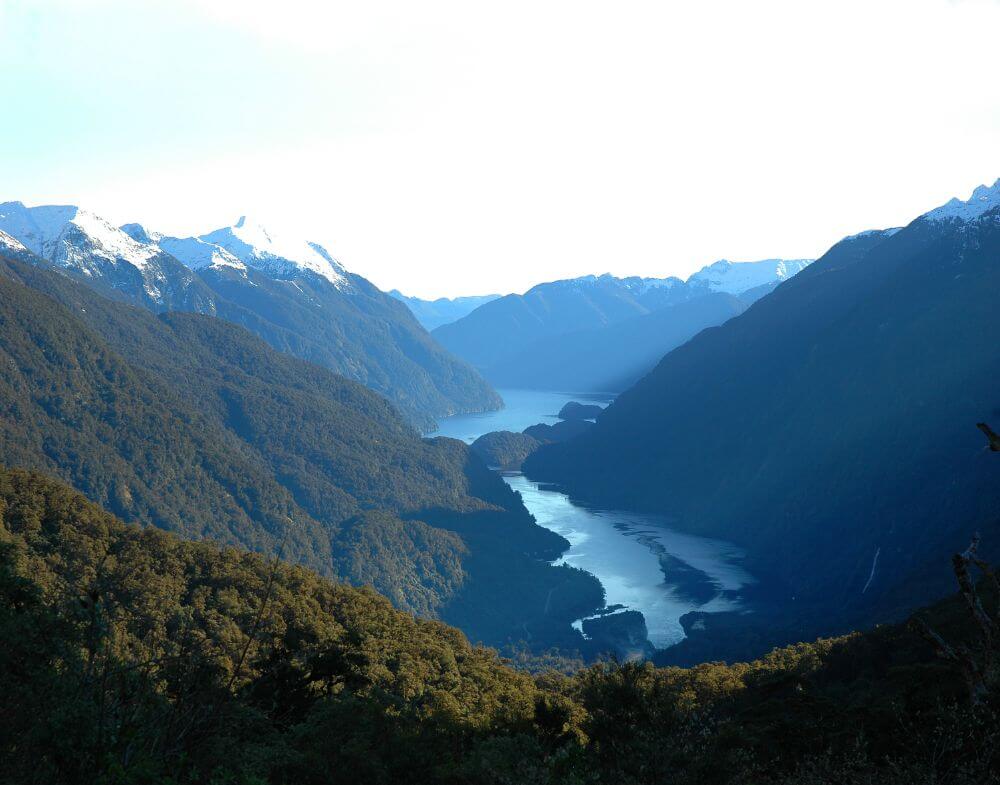
He started, ’the rules onboard Tutoko are simple… there are no rules! That is …apart from having a great time’. He continued, ‘We will get up and start breakfast when we hear you guys scratching about, and finally, would the last one to bed please turn off the lights!’
Those rules sounded pretty bloody good to us, and not wanting to miss the entertainment, Richard was usually there with us most nights to turn off lights.
After the introductions, it was time to break away and explore on the advice of Richard some of the outer spots – we heard there was a low approaching – and if we wanted to experience some of the fishing about the exposed entrance of the sound, now was the time to take a crack at it. At over 40km long and 434m deep, Doubtful Sound is the deepest and second largest of the West Coast fiords – we had some serious area to explore. It was at this time, as we climbed into the boats, it quickly become apparent there was to be a blue team in Greg’s blue Southern and our red team in the Stabi-Craft.
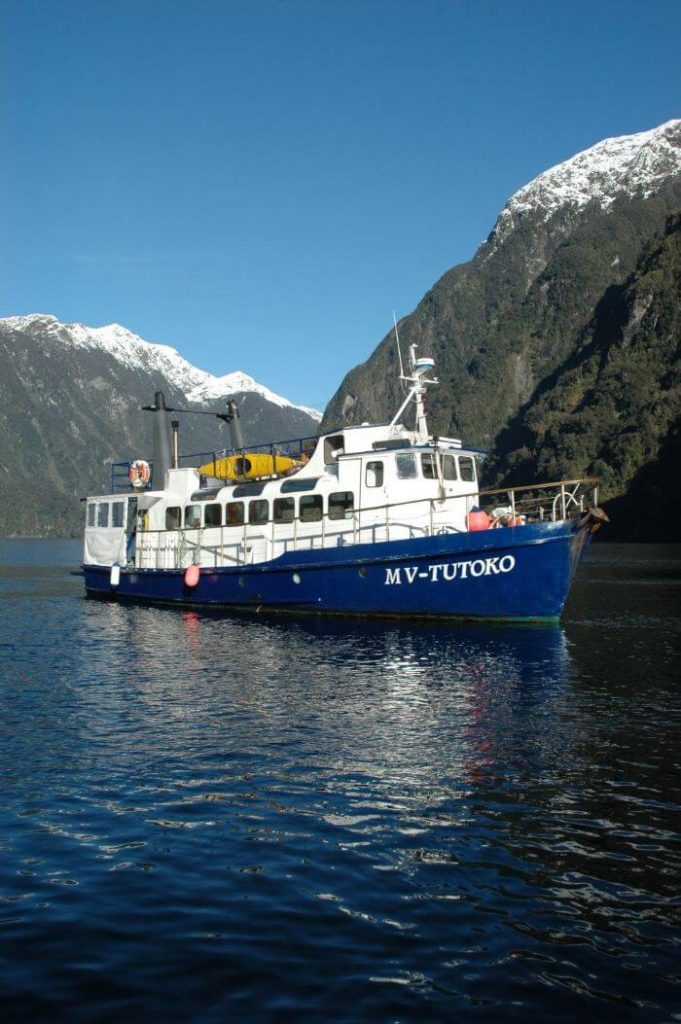
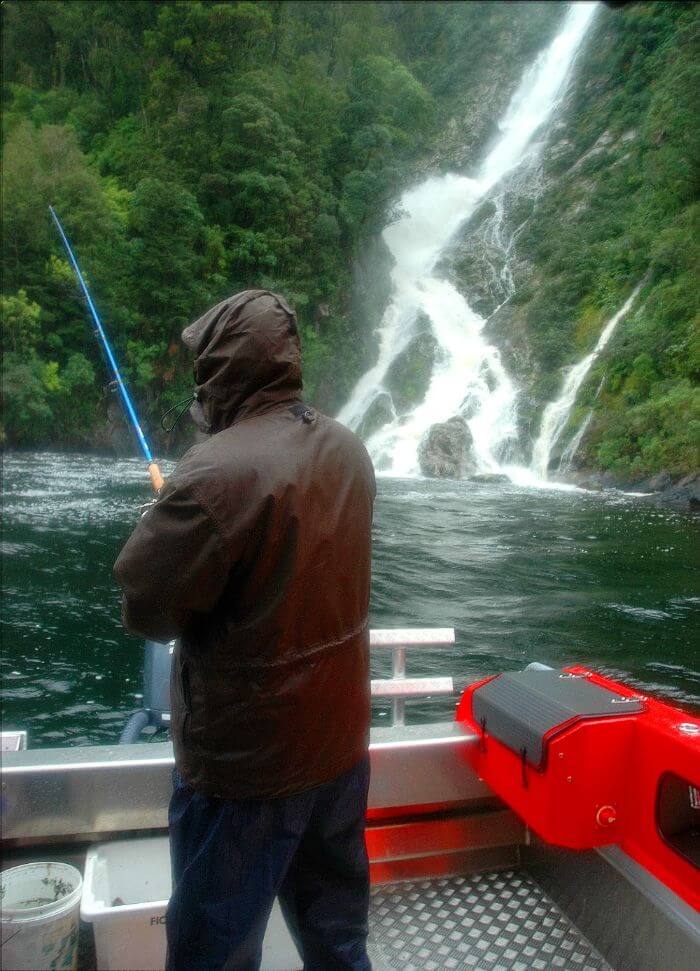
Allan had made some sandwiches for us to take out with us for lunch. Unfortunately for us, the blue team had taken the whole supply, ‘innocently’ thinking it was their provisions. It seemed that the ‘no rules’ policy applied on the water as well.
The blue team stopped for a dive on Bauza Island which lies about a kilometre inside the Sound entrance, while we of the red team continued out to fish a rocky outcrop called Hares Ears, just outside the Fiords entrance at Febrero Point. The one-metre swell did not impede our taking a good catch of blue cod. There was continuous banter over the VHF between the boats which was further intensified once we had discovered we had no lunch onboard – we soon pulled up anchor and moved across to the blue boat who generously passed us over a bag, which we assumed was our lunch, discovering inside – a loaf of dried out unbuttered bread and a packet of salt and vinegar chips! Oh well, better than nothing!
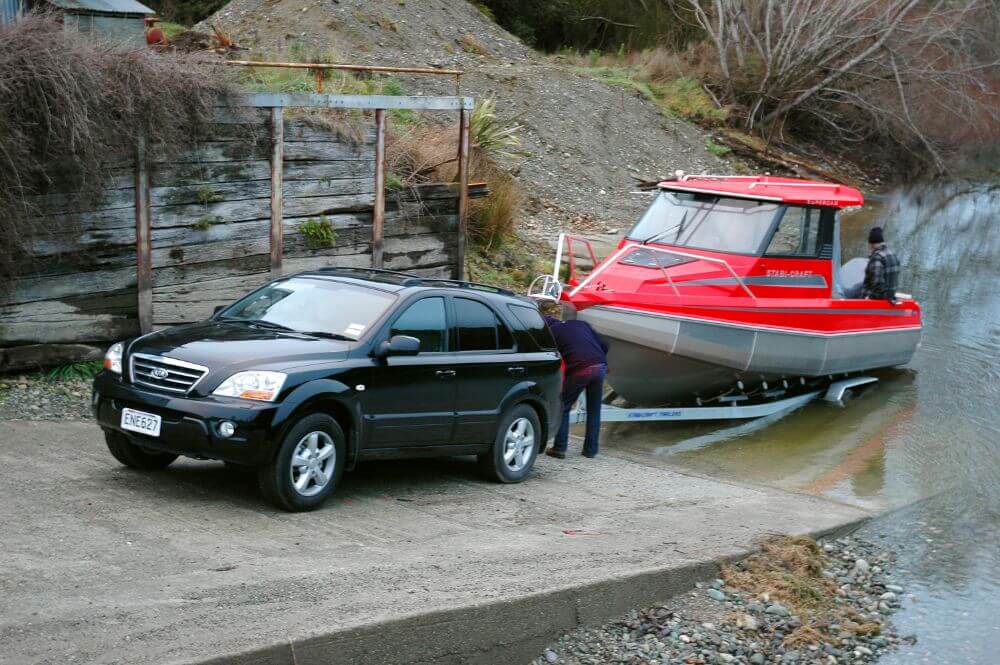
After fishing another couple of spots for blue cod we were soon back to the warmth of our mother ship, Tutoko, anchored that night in the sheltered waters of Blanket Bay, home of Blanket Bay Hotel (a fishermen’s base), one of the few signs of human activity in the sound outside Deep Cove.
Our mother ship, the Tutoko was specifically designed for Fiordland, perfectly set up to provide comfortable accommodation for up to 10 clients. Fiordland Expeditions, the business Richard trades as, offer extended live aboard charters from one to as many nights as you have available. The charters are fully catered and almost everything required for your activities and living aboard is supplied, and therefore all we needed to bring was our personal items, and refreshments.
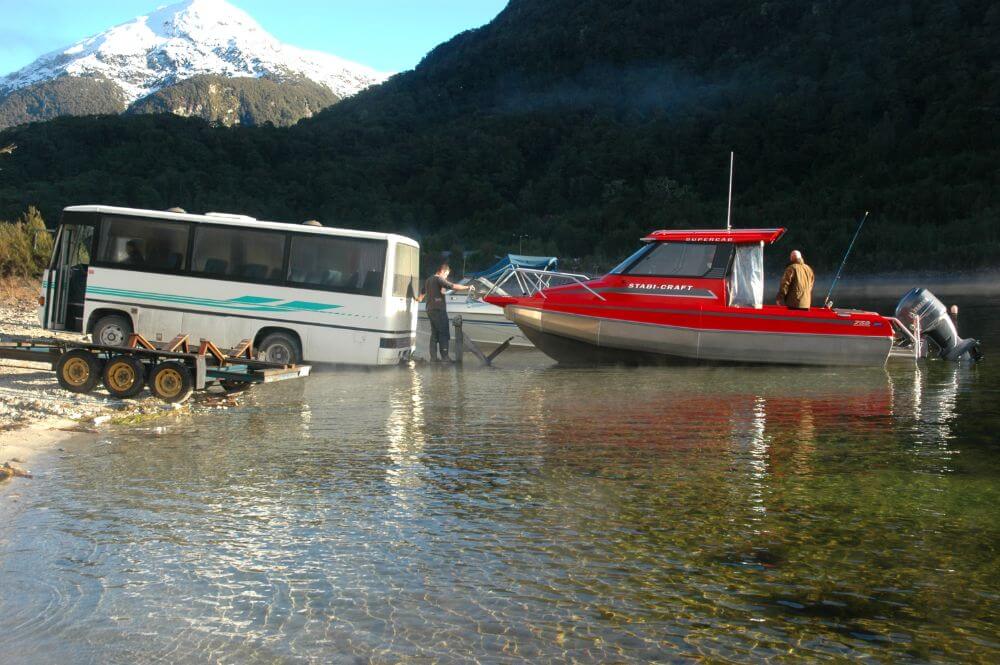
The sleeping quarters were warm and comfortable, considering there were eight of us who had earlier enjoyed crayfish, venison and blue cod, all washed down with a beer and red wine or three, although early on there was fierce competition for bunk positions and the second night for the extra set of earplugs I had brought along!
That first night, safely moored in Blanket Bay, with a delectable feast consumed, it wasn’t long before the mocking was again up and running, fuelled now by a rum or two. To be fair, the red team had brought home a ‘reasonable’ catch of blue cod, which was understandable; after all, the blue team were at a slight disadvantage having two of their team out of fishing action, while below the surface collecting crayfish which we certainly appreciated when it was served up that evening. The teams soon moved on with any mutual respect that we had all enjoyed a great feast brought to the table as a joint effort as a result of both teams.
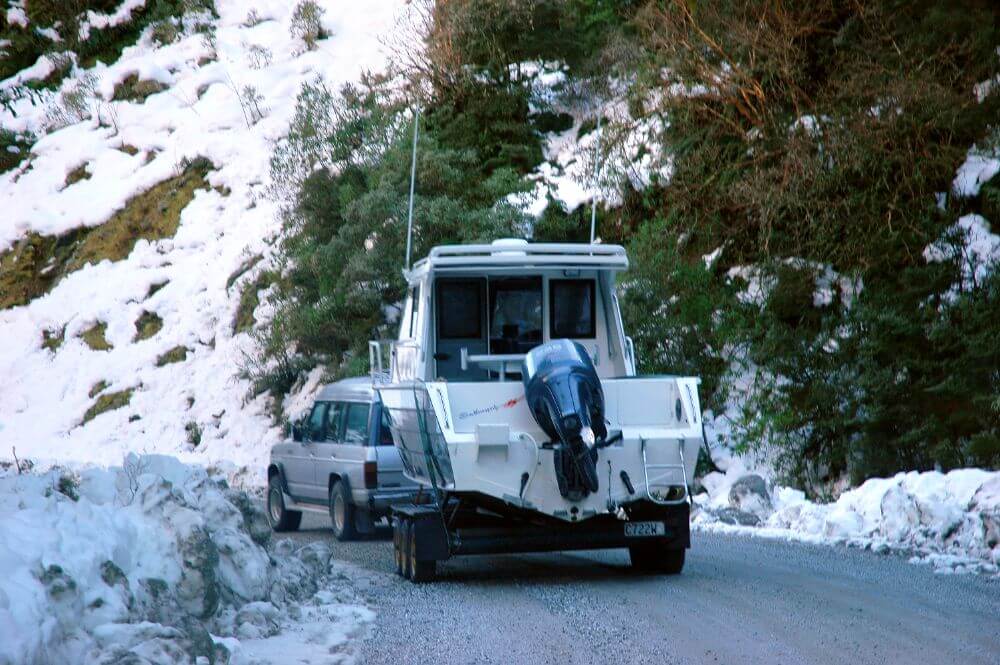
Listening to the dive debrief was unbelievable. The spot they were dropped on was alive with crays, there was little need for searching as the blue boat dive team, Dave and Paul, described the dive best as “a visit to Pak and Save” first filling their catch bag with crays, only to then empty them out, to collect the bigger ones that were tucked in behind the smaller crays originally collected! The visibility was fantastic, basically unlimited. They went on to describe the decent down which took them through a 2 – 3 meter layer of fresh water, then into a confused hazy mix of fresh and salt water followed by the clear deep saltwater layer below.
Other than the crayfish, our divers experienced a wide range of marine species including black coral, said to grow into spectacular ‘trees’ of black coral up to 3 – 4 metres high. It is little wonder Jacques Cousteau named Fiordland as one of his top ten dive spots of the world.
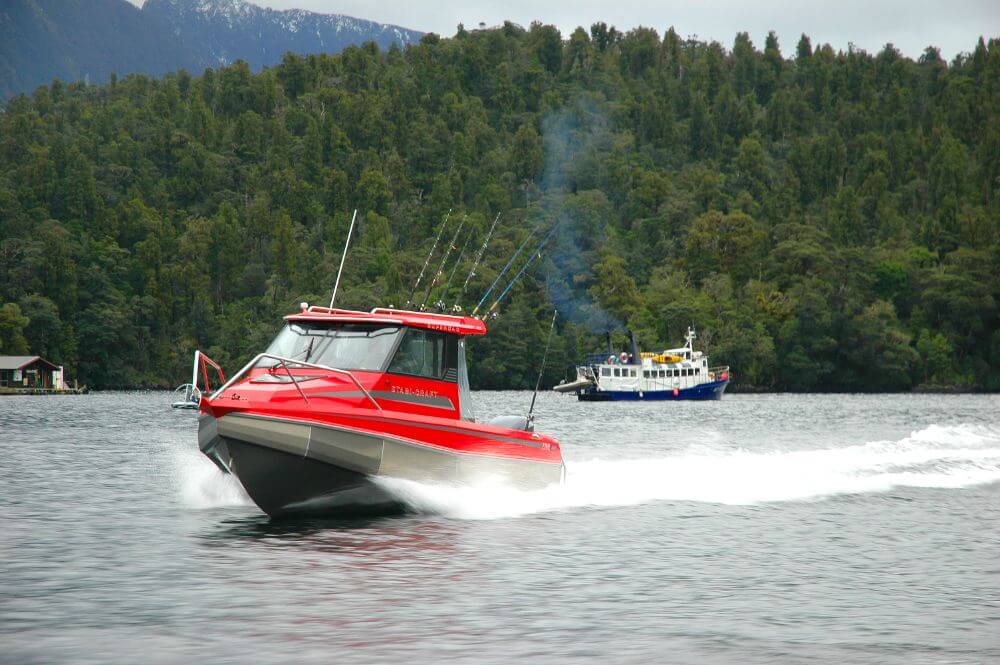
The next morning we woke to grey skies with the mountains covered in mist, the weather had deteriorated as we had expected. Although a little dark and drizzly, enthusiasm was certainly not dampened and after wholesome Tutoko breakfast of sausages, baked beans, hash browns and the staple breakfast blend of scrambled eggs and crayfish we were on our way. It was about this time four of the team of eight thought they should start taking their medication to avoid the inevitable onslaught of gout.
Today being our first whole day to explore the vast wilderness of Doubtful Sound – the second largest of the 14 fiords in Fiordland National Park, (three times longer and 10 times larger than the better known Milford Sound) we decided to head north into one of the two subsidiary sounds – Thompson Sound. Both boats headed up together and explored the new DOC hut built in Deas Cove in Thompson Sound. It is a modern yet basic Hut recently built at a cost of around $550,000 – which has distressed some of the locals. I presume the remoteness has something to do with the costings, although a remarkable setting for those wanting to get right away from it all.
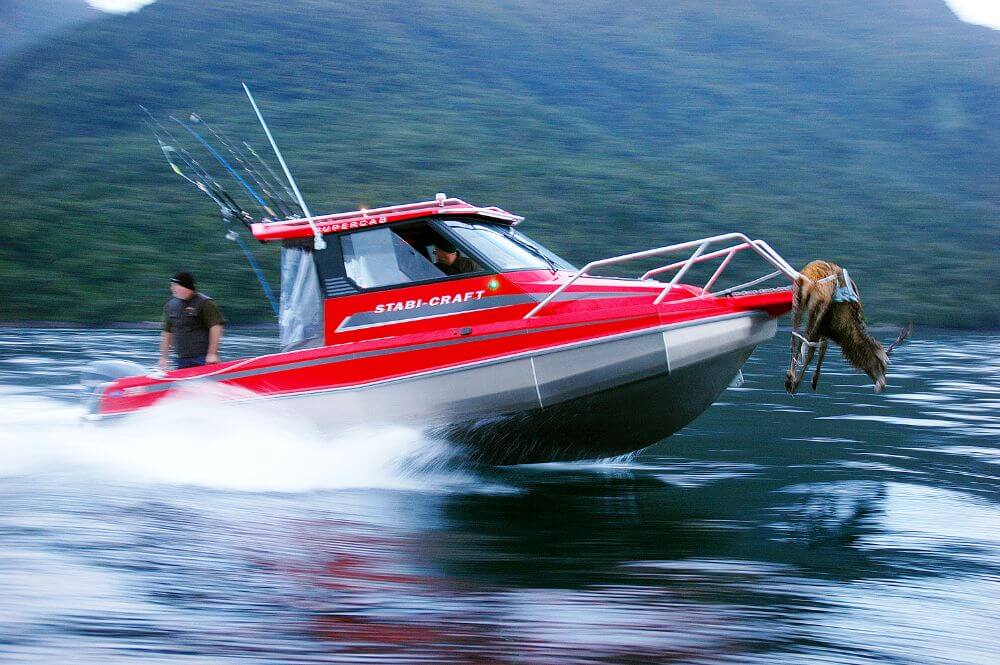
At times the skies cleared and it was relatively pleasant however when a little unpleasant, the combined diversion of the pursuit for blue cod and Groper, the majestic scenery and the wildlife about us, kept the team (dressed in full wet weather gear) more than distracted from the less than perfect weather conditions. The Stabi-Craft 759 SuperCab had plastic clears which we pulled back often and fished under the hard top overhang, keeping relatively dry most of the time, not that it bothered anyone onboard, we were consumed by our surroundings and experiences.
From there it was off again to explore and fish more of the 40 kms of waterways. After a good fish at the Doubtful entrance the day previous we thought we would try the Thompson Sound entrance – unfortunately the results weren’t quite so fruitful. The blue team had more luck right outside Deas Cove where we started, rewarded with a 10.9 lb Blue Cod – and they sure let us know about that over the VHF. Bugger – the pressure was now on. We tried several spots including Pendulo Reach (a fairly busy intersection), in the deep, in the shallows, under waterfalls and river mouths.
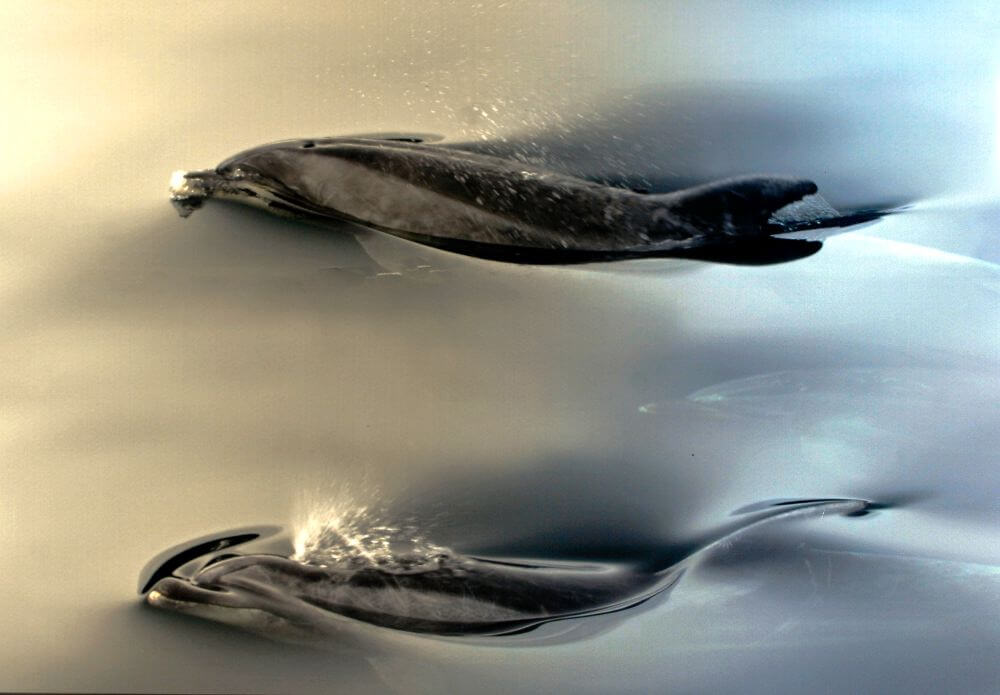
With the evening setting in, time was running out and we were soon due back at Tutoko for the official weigh-in. We spotted the blue team diving at Masterhead, and we put a semi-desperate call in to ‘the local’ Richard (hoping the blue team might not hear) asking for a magic spot that may assist us to attain the big one to beat the trophy winning ten-pounder that the blue team had onboard. Richard directed us to a river mouth, which luckily saved us a ‘downtrou’ that night. Unfortunately for the blue team whose dive kept them out a little longer, meant they were not back on time for the agreed official weigh in, and as you could imagine that was the topic for debate around the table that evening, while anchored within the tranquil waters of Precipice Cove, in Bradshaw Sound, the second subsidiary sound of Doubtful Sound. In the evenings, away from the jovial debating and chat within the Tutoko, you could understand why the area is often referred to as ‘the sound of silence’ absolute peace and stillness.
Wednesday arrived, our second and last full day within this majestic paradise We headed off reasonably early to ensure we gave the day 100%, in an attempt to ensure we, the red Stabi team could today return with our heads held high. We started not far from Precipice Cove and collected a cod or two, until fishing went quiet, a competing fur seal came swimming alongside, time to move on we thought. This was going to be the day of nature and all its creatures it seemed. Bottlenose dolphins ran alongside, guiding us back towards Deas Cove where the blue team had caught the ten-pounder the previous day.
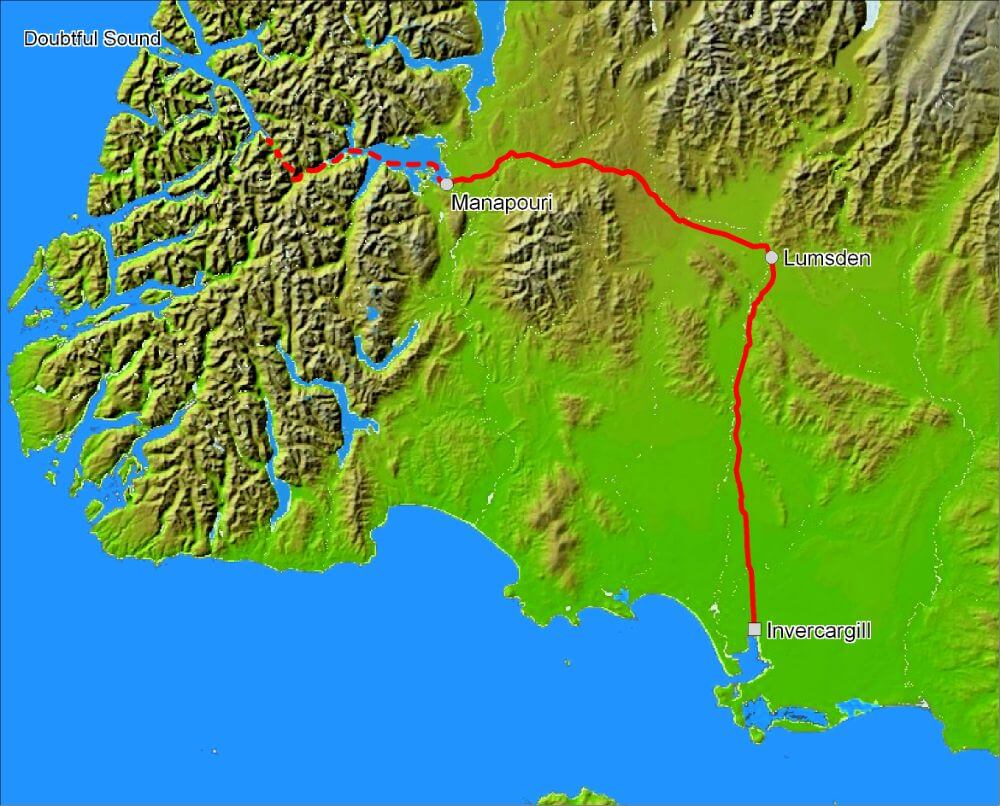
We tried a spot or two before we arrived at Deas Cove to find the blue team back trying their luck on their spot again. Greg had wandered off with his rifle past the DOC hut towards a slip, with the hope of spotting a deer, while the blue boat boys had a dive and fish back at Deas Cove. We came across a nice hole still within sight of the blue boat – sure enough we had found a great Blue Cod spot. We spent the next 30 minutes drifting across the hole installing confidence that we could now return to Tutoko today with our heads raised. While working our hole, we heard three shots ring out. Yeah right we thought – Bloody Greg having us on again! We continued drifting across the hole a little longer before we heard a proud voice on the VHF asking us to come around to the next bay to give Greg a hand with a little job. Yep the Blue boat had done it again – just when we thought we had them with our healthy Blue Cod catch. Greg took us about 200 metres into the bush to show us not one but two deer!!! Not something the Auckland boys see back home, and a good opportunity Greg thought for a couple of Aucklanders experience carrying a deer out. Good on ya mate – as a Speights drinking southerner would say. What a day, Blue cod, crayfish and now venison – what more could you ask for???
We ventured back to Tutoko feeling very proud of our efforts – seeing as we carried the deer out, we became one team again. Luckily we had a couple of hunters onboard who managed to do a pretty good job of boning and butchering the deer, enabling the team all to take home a pretty good feed of crays, blue cod and venison.
That evening we all celebrated together recalling our activities and experiences of the previous three days in Doubtful sound and surroundings.
Day four arrives and unfortunately, our time to leave this tranquil wilderness was nearing. Waking again in the beautiful Blanket Bay, I look about the surrounding area, feeling humble, while energized by the physical grandeur of Doubtful Sound and its neighboring mountains.
The time spent with the Tutoko team was fantastic, whatever ‘blows your hair back’ whether fishing, diving, hunting, kayaking, bush walks, or just taking in a scenic cruise, Richard and his team will guide you as he did for us, to where it’s happening. After our farewells to Richard and Allan it was time to head back over Wilmot Pass.
The tow back
When Phil dropped us off four days earlier I had asked him on the side whether he could organise a quick tour of the Power station – which he said he would check on. Once we arrived back to the Manapouri side, Phil drove us to entrance of the Power station. It was then a two-kilometer spiral tunnel drive down into the depths of the mountain via the access tunnel to the power station where we viewed the turbines in action – quite an experience and a nice bonus added to the end of the expedition. After the power station tour it was back in the water, motor across Lake Manapouri, into the cars for the tow back to Invercargill for one last meal together and debrief of the adventure.
The inclusive boating expedition of 140 nautical miles, right back to Pearl harbour, Manapouri, the StabiCraft 759 SuperCab, powered by a 250HP four stroke Yamaha consumed approx three quarters of its 275 litre tank – quite reasonable considering the amount of time we spent idling, exploring at slow speeds investigating holes and holding in position over holes and alongside waterfalls, attempting to catch the illusive groper. Petrol is available in Doubtful sound, delivered by a tanker, barged over every Wednesday at a cost of around $3-00 per litre.
The Kia Sorento (Limited model) we used for the tow vehicle towed exceptionally – the whole team were ‘blown away’ by the performance, which we all thought was a bit miss-matched up against the 759 Stabi-Craft SuperCab. The whole Sorento range is powered by a 2.5-litre DOHC turbocharged common rail diesel engine that delivers 125kW of power and 392Nm of torque. The standard 5-speed automatic transmission equipped with sport shift stood up well, offering a towing capacity of 2.8 tonnes, towing well and extremely economically. We have approached Kia Motors regarding a press vehicle to put through its paces – look for the write-up in the next issue of Propeller magazine.
In Summary
Our Propeller magazine 2008 expedition into Doubtful Sound will be an adventure never forgotten by any of us – the Tutoko team ensured that! Good friends enjoying an abundant, unspoilt wilderness, a place of many moods; one minute clear blue skies and sun-drenched, the next mysterious and mist-cloaked. If you ever get the opportunity to visit Doubtful Sound, grab it with both hands and go!




